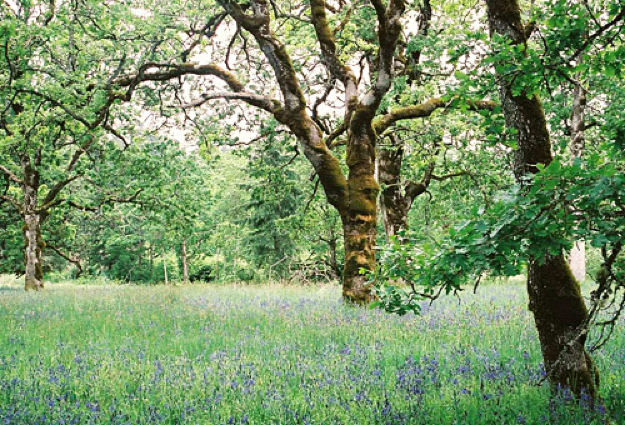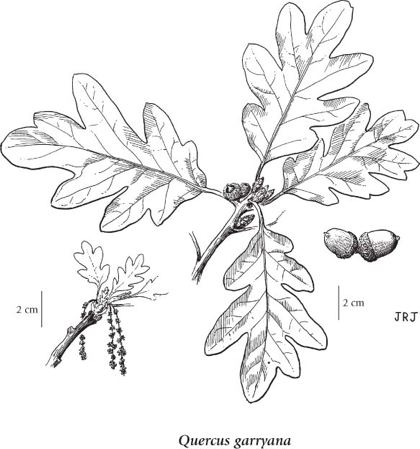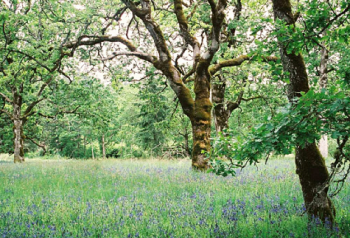Garry Oak (Quercus garryana)

Common Name(s): Garry Oak, Oregon White Oak
Scientific Name(s): Quercus garryana
Island Hulkemel’em Name(s): p'xwulhp
Family: Fagaceae
Cautions: None
Botanical Description: The garry oak is a deciduous tree with heavy, scraggy branches, up to 25 m tall. But it is common for them to be small, shrubby and as short as 1 m usually found in dry, rocky habitats. Trunks span up to 1 m wide and the bark is light grey with thick scaly ridges. It has deeply lobed leaves (3-7 per side) which are bright green and glossy above and paler with red to yellow hairs underneath. Garry oaks also have acorns that are small in size with a shallow scaly cup on one end.[1]

Current Distribution and Local Habitat(s): In Canada, garry oaks are found in Southeastern Vancouver Island and the Gulf Islands, with some isolated groups of trees in the lower Fraser Valley, making it the only native oak species that occurs in Western Canada. However, it ranges down the coast into the state of Washington and down into southern California as well. Garry oaks can thrive in hot, dry environments, which is likely why they flourished when indigenous groups were using land management techniques employing the use of fire.[2]
Ethnobotanical Application(s): Garry oak meadows were once extremely important to the Coast Salish peoples of British Columbia. Garry oak meadows were a very common sight throughout southeastern Vancouver Island and were heavily managed by indigenous communities. The Vancouver Island Coast Salish people deliberately managed the land and periodically used prescribed burning to keep the meadows clear of underbrush and to promote the growth of camas which is a culturally important species. Garry oak trees themselves were used by coastal peoples for combs and digging sticks as well as for fuel. They also ate the acorns either roasted or steamed. Garry oak trees also have a wide variety of medicinal uses. Any galls produced on the tree are strongly astringent and can be used in the treatment of hemorrhages, chronic diarrhea, dysentery etc. A decoction of the bark has been used in the treatment of tuberculosis. The bark can also be made into a tea which was either drank, gargled, or used in medicinal washes to treat inflamed gums, sore throats, diarrhea, menstrual problems, burns, cuts, scrapes, insect bites, and rashes. The bark contains a high amount of tannins and quercin. Tannins have antibacterial and antiviral properties, and quercin strengthens capillaries, which is why the bark can be used to treat a plethora of different ailments.[3]
Herbal Tea Recipe:
You will need one and a half tablespoons of garry oak bark per cup of water. If possible, use fallen tree branches and carefully use a knife to scrape off the bark. If not possible then remove bark from the South side of the trunk where it will regenerate lost bark fastest, while doing this take caution as to avoid removing too much or going through to the cambium layer and potentially damaging it. Dry the bark for a week minimum and then grind or pound the bark until it is broken up into a mixture of smaller pieces and/or powder. Either directly place one and a half cups into a boiling cup of water, or fill an empty tea bag with the bark and steep it for about 10-15 minutes. If directly placed in water strain the tea first and enjoy!
UVic Campus Location(s): Alumni Garry Oak Meadow.
Figure Reference(s):
Figure 1: http://linnet.geog.ubc.ca/Atlas/Atlas.aspx?sciname=Quercus%20garryana
Figure 2: https://www.for.gov.bc.ca/hfd/library/documents/treebook/garryoak.htm
[1] Garry Oak Meadows. 2013. Retrieved June 29, 2016, from https://www.crd.bc.ca/education/our-environment/ecosystems/terrestrial/g...
[2] BC Forest Ministry. n.d. Garry oak. Retrieved June 29, 2016, from https://www.for.gov.bc.ca/hfd/library/documents/treebook/garryoak.htm
[3] Turner, N. (2014). Ancient Pathways, Ancestral Knowledge. Ethnobotany and Ecological Wisdom of Indigenous Peoples of Northwestern North America. Retrieved June 29, 2016, from https://dspace.library.uvic.ca/bitstream/handle/1828/5091/Appendix 2B UVicSpace Indigenous names of native species_BIG.pdf?sequence=5&isAllowed=y.
Project Status:
Date Completed:
Year:
Associated Projects:
Image:

